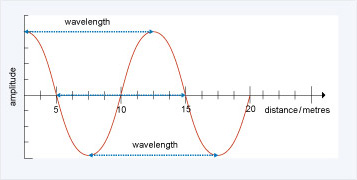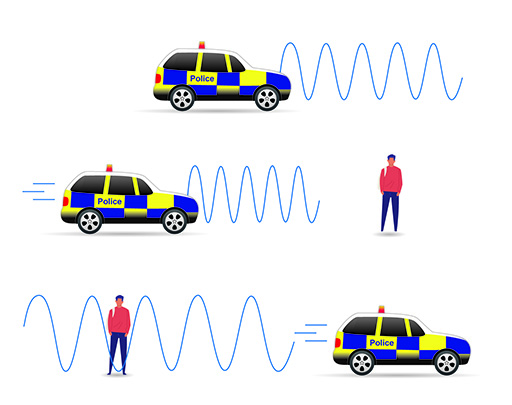4.2 Light as a wave and the Doppler effect
You can measure a star’s wobble by looking at the light from the star. Light and sound are both waves, and have some things in common with the waves you can see on lakes and oceans. You can’t directly see the crests and troughs of the waves of light and sound, but your eyes and ears are sensitive to them. The properties of light waves and sound waves are rendered into the colour of light and the pitch of sound by your eyes and ears.
The colour of light is determined by its wavelength, which is the distance between the crests of the waves. In the same way, the pitch of a sound is also determined by its wavelength. Longer wavelengths of light and sound correspond to redder colours and lower pitches, and shorter wavelengths to bluer colours and higher pitches.
Figure 5 shows how wavelength is measured: it is the space between two consecutive peaks or two consecutive troughs in a wave. For this wave, the wavelength is 10 metres.
If the object emitting light or sound is moving relative to the person seeing the light or hearing the sound, then the light or sound waves can seem to be stretched or compressed.
This is why the pitch of a police car siren sounds higher when the police car is coming towards you, and then drops when the police car goes past and moves away from you (Figure 6). This stretching and compression of waves emitted by a moving object is called the Doppler effect.
As the police car travels towards the listener the sound waves are compressed, the wavelength shortens, and the pitch sounds higher (the second picture in Figure 6). Once the car has passed and begins to travel away, the sound waves are stretched out, the wavelength lengthens and the pitch becomes lower (the third picture in Figure 6).
The effect is more extreme the faster the car is moving: the sound waves become even more compressed or stretched out. This means that a faster car will have a siren sounding even higher or lower pitched.
So, the speed at which the police car is moving changes how marked the effect is, while the direction in which the police car is moving determines whether you hear a higher or lower pitch. To understand what has happened to the sound from the siren, you need to know the velocity of the car, not just the speed.
Something very similar happens when stars wobble, but rather than hearing the effect in sound waves you can see it in light waves. As a star moves around the centre of mass of the star–planet system, its light is repeatedly stretched and compressed. A stretch as the star moves away makes the wavelength slightly longer, and compression as the star comes towards you makes the wavelength slightly shorter. Of course, planets take longer to complete an orbit than the time a police car would take to pass you in the street. This means that some patience is required to measure the wavelength changes: it can take days, months, years or even decades, depending on the time taken for a planet to complete an orbit.
If you can detect the tiny wavelength changes caused by this stretching and compression, then you know the star is moving. If you see the movement repeat itself, you can work out that the star is in an orbit. For this to happen, the star must have a companion star or planet with which it is in orbit.
Even more remarkably we can work out the mass of the star’s companion. The motion of a star is caused by the gravity of a moving companion that pulls on the star. How much a star moves depends on how strong the gravity of its companion is. The strength of the gravitational pull depends on the mass of the companion. This means that, by measuring the wavelength changes caused by the Doppler effect, you can work out the companion’s mass. More massive companions will make a star move faster, and therefore make the wavelength of the light change more.


